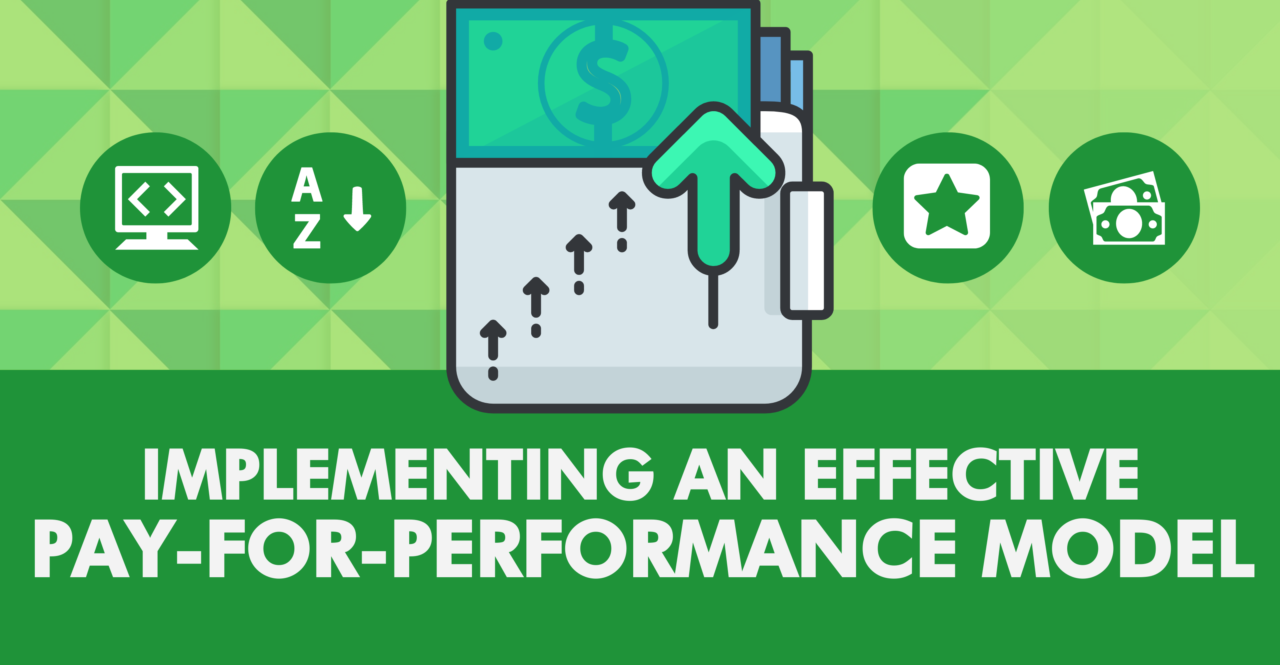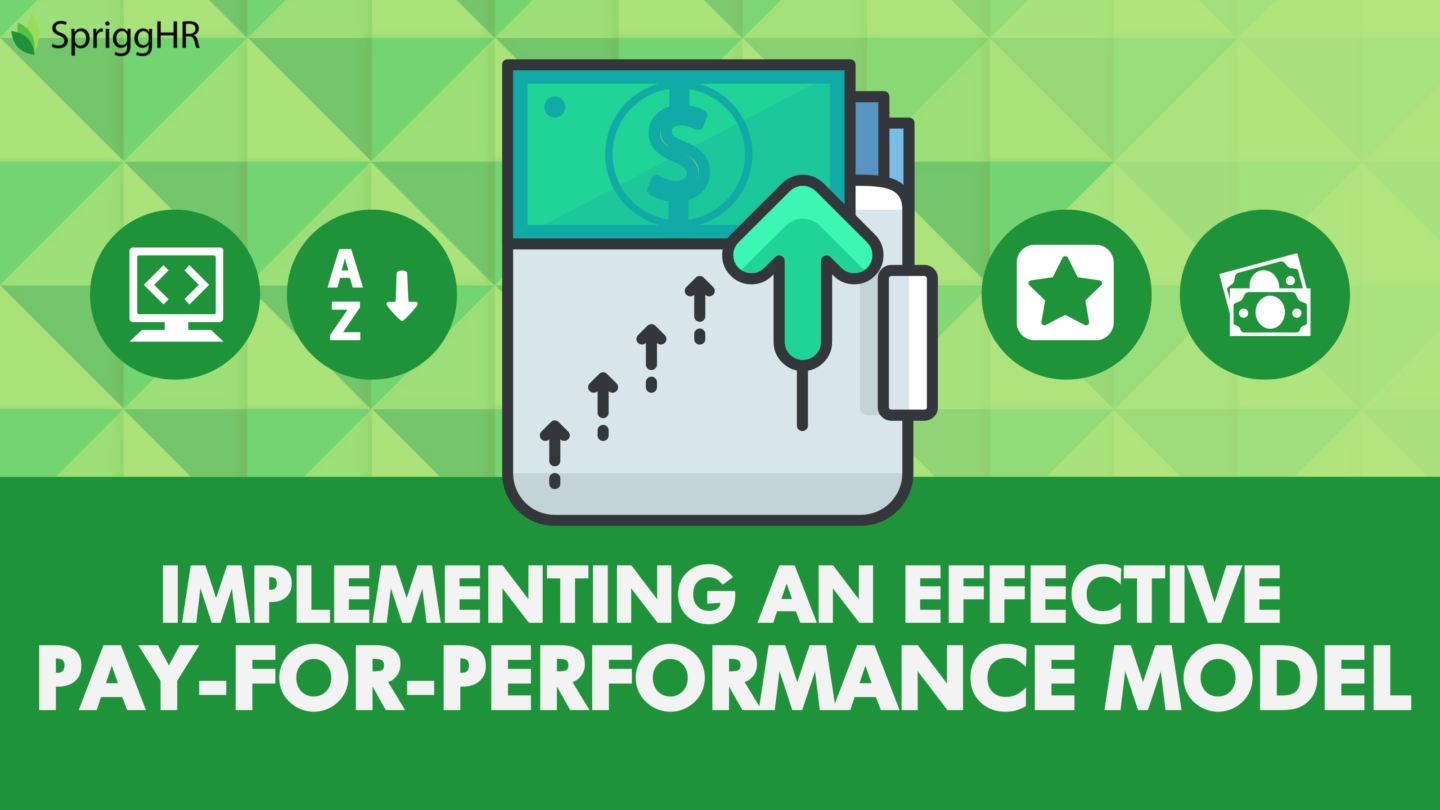
Implementing an Effective Pay-for–Performance Model
Pay-for-performance compensation describes performance-based pay programs where an employee is incentivized and rewarded for achieving goals or objectives.
In a hurry? Take our Implementing an Effective Performance Management White Paper to go!

Pay-for-Performance
Send download link to:
What is Pay-for-Performance?
The pay-for-performance model moves away from systematic entitlements when it comes to compensation, and instead signals a more mature and fair approach to employee salaries. It works to drive employee engagement and is also effective in boosting top talent retention. Despite being a complex model that can manifest in several different forms, hinging on budget, goals, company size, and so on, pay-for-performance can be grouped into two principle categories:
Merit Pay Increases
These refer to the increases in an employee’s base pay due to high performance that are typically delivered on an annual basis. They are often already budgeted for, included as part of the annual salary increase budgeting process. This is the most used pay-for-performance model, recognizing employee performance and rewarding top performers with an increased base salary for the following year.
Variable Pay Programs
These encompass an array of both discretionary and non-discretionary bonuses, varying according to the payout period, employee eligibility, and employee measurement metrics. Unlike merit pay increases, variable pay programs are often administered multiple times a year (i.e. once a quarter), and a mix of different programs are often employed.
Some variable pays programs include:
Discretionary Bonuses
These are awarded on an ad-hoc basis to the employees demonstrating outstanding performance, and often without consideration of pre-defined goals. This can include:
- Spot bonuses: reward employees “on the spot” for achievements that deserve special recognition.
- Project bonuses: reward employees for completion or superior completion of a project.
- Retention bonuses: usually awarded to long-tenured employees, or employees in “hot jobs”, to decrease their flight risk.
Nondiscretionary Bonuses
These are awarded when employees, teams, or the entire company meets specific, pre-defined goals. They are based on the duration of the assessment period and are considered either short-term incentives or long-term incentives. This can include:
- Company-wide bonuses: focused around specific improvement goals for the company, rewarding employees based on how much improvement is made on these goals over a certain period of time.
- Team-incentive bonuses: focused around specific improvement goals for one specific team, rewarded based on the performance of that team.
- Individual incentive bonuses: based on predetermined, measurable business objectives (MBOs), that are evaluated periodically based on an individual employee’s performance.
Is Pay-for-Performance Really Working?
Pay-for-performance compensation can come in many different forms depending on an organization’s budget, compensation philosophy, and organizational goals. However, despite their usefulness in building a competitive compensation plan, very few organizations have feasible and effective pay-for-performance models in place.

The Pros and Cons of a Pay-for-Performance Model
Despite embracing its concept, many employers claim that their pay-for-performance programs are failing in driving and rewarding individual or group performance.
In a Talent Management and Rewards Pulse Survey conducted by Willis Tower Watson, a surprisingly large number of North American employers claimed their programs were not accomplishing what they had promised they would do. Specific findings included:
- Only 20% North American companies find pay-for-performance effective in driving higher levels of individual performance at their organization.
- Only 32% claimed that their performance-based pay program is effective in differentiating pay based on individual performance.
- 53% agreed that annual incentives are ineffective in differentiating pay based on how well employees perform.
The survey also pointed out the discrepancies in employee’s understandings of how merit is specifically measured, with their understandings of the merit-influencing values not aligning with their employers. For example, two-thirds (64%) of employees claim the managers at their organization consider the demonstration of knowledge and skills in an employee’s current role when making pay-increase decisions. However, less than half (46%) claim their programs are designed to take these performance indicators into consideration.
Pay-for-performance models can be great tools in driving performance and recognizing and reward top-performing employees, but only when they are designed and implemented correctly. Traditional thinking on merit-based pay is no longer applicable – companies instead need to define what performance means specifically for their organization, and what managers can do to ensure they are driving the right performance. Re-evaluation the objectives of rewards programs can help to realign pay-for-performance models with their benefits, rather than misaligning them and causing detriments.
Implementing an Effective Pay-for-Performance Model
While the concept of constructing and implementing a merit-based compensation model may seem daunting to many organizations, there are several tricks you can use to do it effectively and ensure it is sustainable in the ever-changing job market.
Most employee performance can be classified into one of the two categories:
1. Qualitative Performance – activities related directly to customer experience and outcomes, such as sales, customer satisfaction, employee engagement, employee productivity, etc.
2. Quantitative Performance – activities related to the operations side of the organizations, such as programming, accounting, administration, etc.
Once an employee’s performance is quantified, it becomes much easier to link their performance to rewards, guiding you towards a fair and flexible pay-for-performance model suitable to your organization.
Best Practices in Linking Performance to Rewards
Identify the triggers for top performers.
Not every employee will view higher base pay or bonuses as the ultimate form of reward. Management should recognize what specifically drives engagement and productivity in their top performers, allocating the annual budget to flow into these triggers specifically.
Identify clear-cut objectives for employees.
Pay-for-performance heavily relies on both the employee’s and the employer’s understanding of what good performance actually looks like. When the ‘what’ of performance is clearly articulated, employees will have a better understanding of what they’re working towards, making the measurement of performance against your model much more cohesive.
The Benefit of Linking Pay to Performance
The objective of any pay-for-performance model should be maintaining a structure that rewards the employees who best contribute to organizational and departmental goals. Establishing fair and consistent practices in how you reward and compensate performance is critical.
SpriggHR’s Compensation Tools are an effective solution that helps you to accurately link pay to performance, tracking essential compensation activities and reporting.
Create a fair and consistent approach to your compensation strategy by establishing adjustments that directly link an individual’s pay raise or bonus allotment to the results of their own performance.




